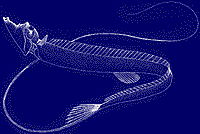 A black hole is an object with a gravi tational field so powerful that a region of space becomes cut off from the rest of the universe – no matter or radiation, including visible light, that has entered the region can ever escape. The lack of escaping electromagnetic radiation renders the inside of black holes (beyond the event horizon) invisible, hence the name. However, black holes can be detectable if they interact with matter, e.g. by sucking in gas from an orbiting star. The gas spirals inward, heating up to very high temperatures and emitting large amounts of light, X-rays and Gamma rays in the process while still outside of the event horizon.[2][3][4] Black holes are also thought to emit a weak form of thermal energy called Hawking radiation.[5][6][7]
A black hole is an object with a gravi tational field so powerful that a region of space becomes cut off from the rest of the universe – no matter or radiation, including visible light, that has entered the region can ever escape. The lack of escaping electromagnetic radiation renders the inside of black holes (beyond the event horizon) invisible, hence the name. However, black holes can be detectable if they interact with matter, e.g. by sucking in gas from an orbiting star. The gas spirals inward, heating up to very high temperatures and emitting large amounts of light, X-rays and Gamma rays in the process while still outside of the event horizon.[2][3][4] Black holes are also thought to emit a weak form of thermal energy called Hawking radiation.[5][6][7] While the idea of an object with gravity strong enough to prevent light from escaping was proposed in the 18th century, black holes as presently understood are described by Einstein's theory of general relativity, developed in 1916. This theory predicts that when a large enough amount of mass is present within a sufficiently small region of space, all paths through space are warped inwards towards the center of the volume. When an object is compressed enough for this to occur, collapse is unavoidable (it would take infinite strength to resist collapsing into a black hole). When an object passes within the event horizon at the boundary of the black hole, it is lost forever (it would take an infinite amount of effort for an object to climb out from inside the hole). Although the object would be reduced to a singularity, the information it carries is not lost (see the black hole information paradox).
While general relativity describes a black hole as a region of empty space with a pointlike singularity at the center and an event horizon at the outer edge, the description changes when the effects of quantum mechanics are taken into account. The final, correct description of black holes, requiring a theory of quantum gravity, is unknown.
**************************************************************
 It is now believed that at the center of each galaxy there is a super-massive black hole that is millions to billions of times heavier than our sun. The massive black hole captures nearby stars and drags them into a swirling accretion disk. A "torus" in the inner accretion shields the black hole in those systems that are viewed edge on (which is probably the case for our galactic center). In many of these systems (which are called AGN = active galactic nucleus), a jet is ejected perpendicular to the disk and is seen in the optical and radio wavebands. In the very central regions the disk becomes so hot (tens of millions of degrees) that the emission is in the X-ray and Gamma-ray bands. This animation shows an artist's impression of the view from an approaching spaceship. The HEASARC data archives contain many observations of these systems made with orbiting X-ray and Gamma-ray observatories.
It is now believed that at the center of each galaxy there is a super-massive black hole that is millions to billions of times heavier than our sun. The massive black hole captures nearby stars and drags them into a swirling accretion disk. A "torus" in the inner accretion shields the black hole in those systems that are viewed edge on (which is probably the case for our galactic center). In many of these systems (which are called AGN = active galactic nucleus), a jet is ejected perpendicular to the disk and is seen in the optical and radio wavebands. In the very central regions the disk becomes so hot (tens of millions of degrees) that the emission is in the X-ray and Gamma-ray bands. This animation shows an artist's impression of the view from an approaching spaceship. The HEASARC data archives contain many observations of these systems made with orbiting X-ray and Gamma-ray observatories.

















 Before the existence of a human form on earth, it is said that there is an existence of other life form in the galaxy. Galaxy has been comprises of Billions of counts in the entire Universe. Just imagine how big the galaxy was and thus the Universe could have been limitless in wide. On the other hand, every galaxy could contain a life form other than the human beings, and these are we known as Extra Terrestrials or Aliens. Many astronomers and some famous researcher believed on their existence and they were claiming that the life of an ET or an Alien more advance than ours. It is my interest to discover more related to the other life form in the Universe and I was really relying to some person here on earth that are keen to discover such diversified facts and bring out more evidences and truths beyond this very interesting topic.
Before the existence of a human form on earth, it is said that there is an existence of other life form in the galaxy. Galaxy has been comprises of Billions of counts in the entire Universe. Just imagine how big the galaxy was and thus the Universe could have been limitless in wide. On the other hand, every galaxy could contain a life form other than the human beings, and these are we known as Extra Terrestrials or Aliens. Many astronomers and some famous researcher believed on their existence and they were claiming that the life of an ET or an Alien more advance than ours. It is my interest to discover more related to the other life form in the Universe and I was really relying to some person here on earth that are keen to discover such diversified facts and bring out more evidences and truths beyond this very interesting topic.







